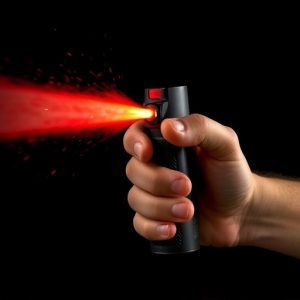How to Treat and Prevent Pepper Spray Exposure: A Comprehensive Guide
TL;DR: To treat pepper spray exposure, immediately move to fresh air, remove contaminated clothing,…….
TL;DR: To treat pepper spray exposure, immediately move to fresh air, remove contaminated clothing, wash affected areas with water and mild soap for 15 minutes, apply cold compresses, and seek medical attention if symptoms persist or breathing is impacted. Preventative measures include wearing protective gear and carrying personal security products.
Personal security is a vital concern in today’s world, and understanding defensive products like pepper spray is essential. This comprehensive guide delves into the various aspects of pepper spray exposure, offering insights on its causes, symptoms, and immediate treatment steps. We explore long-term care strategies and prevention tactics to ensure folks are equipped with knowledge on how to treat pepper spray exposure effectively. By the end, you’ll be armed with valuable information to navigate potential situations safely.
- Understanding Pepper Spray Exposure: Causes and Symptoms
- Immediate Steps for Treating Pepper Spray Exposure
- Long-term Care and Prevention Strategies for Pepper Spray Injuries
Understanding Pepper Spray Exposure: Causes and Symptoms
Pepper spray, an inflammatory defense product designed for personal security, can cause significant discomfort and even serious health issues if exposed improperly. Understanding how pepper spray interacts with the body is crucial in learning how to treat pepper spray exposure. When deployed, pepper spray releases capsaicin, a compound found in chili peppers, which triggers pain receptors in the eyes, nose, and respiratory system. This reaction can lead to symptoms like teary eyes, difficulty breathing, coughing, and temporary blindness.
Effective treatment for pepper spray exposure involves immediate action. First, move to an area with fresh air to prevent inhalation of residual capsaicin. Remove any contaminated clothing or accessories carefully, washing hands thoroughly afterwards. Applying a cold compress to the affected areas can help reduce pain and swelling. In severe cases where symptoms persist or breathing becomes severely impacted, seek medical attention promptly.
Immediate Steps for Treating Pepper Spray Exposure
In the event of pepper spray exposure, immediate and proper treatment is crucial to mitigate discomfort and potential health risks. If exposed, take a few swift actions. First, move to a safe, open area away from the source of the spray to prevent further inhalation or contact with your skin. Remove any contaminated clothing or accessories, being careful not to rub your eyes or face. Rinse your eyes thoroughly with clean water for at least 15 minutes, ensuring you blink frequently to help flush out any remaining irritants.
For skin contact, gently wash the affected area with soap and water. Do not use harsh chemicals or alcohol as they can exacerbate irritation. If breathing becomes difficult, seek fresh air immediately and apply a cold compress to your face to ease discomfort. It’s advisable to consult medical professionals for severe reactions or if symptoms persist beyond temporary irritation.
Long-term Care and Prevention Strategies for Pepper Spray Injuries
Pepper spray injuries, while often temporary, can cause significant discomfort and even long-lasting effects if not properly managed. Long-term care for victims involves a multi-step approach to mitigate pain and promote healing. The first step is thorough washing of the affected area with plenty of water to dilute the pepper spray residue. This should be done immediately upon exposure to minimize irritation. Additionally, using mild soap can help remove any remaining chemicals.
Prevention strategies are equally vital to avoid pepper spray injuries. Wearing protective gear such as goggles and gloves during potential encounters is crucial. Regularly updating and maintaining these items ensures their effectiveness. Individuals in high-risk areas may also consider carrying personal security inflammatory defense products, like pepper spray, for immediate use. Knowing how to treat pepper spray exposure through proper cleaning and protection can significantly reduce the impact of such incidents.
Understanding pepper spray exposure, its causes, and symptoms is crucial for knowing how to treat it effectively. Immediate action after exposure is key, including thorough washing of the affected area and seeking medical attention if needed. Long-term care involves proper decontamination techniques and prevention strategies to reduce the risk of future incidents. By following these steps and staying prepared, individuals can better navigate potential pepper spray exposures, ensuring their safety and well-being.


